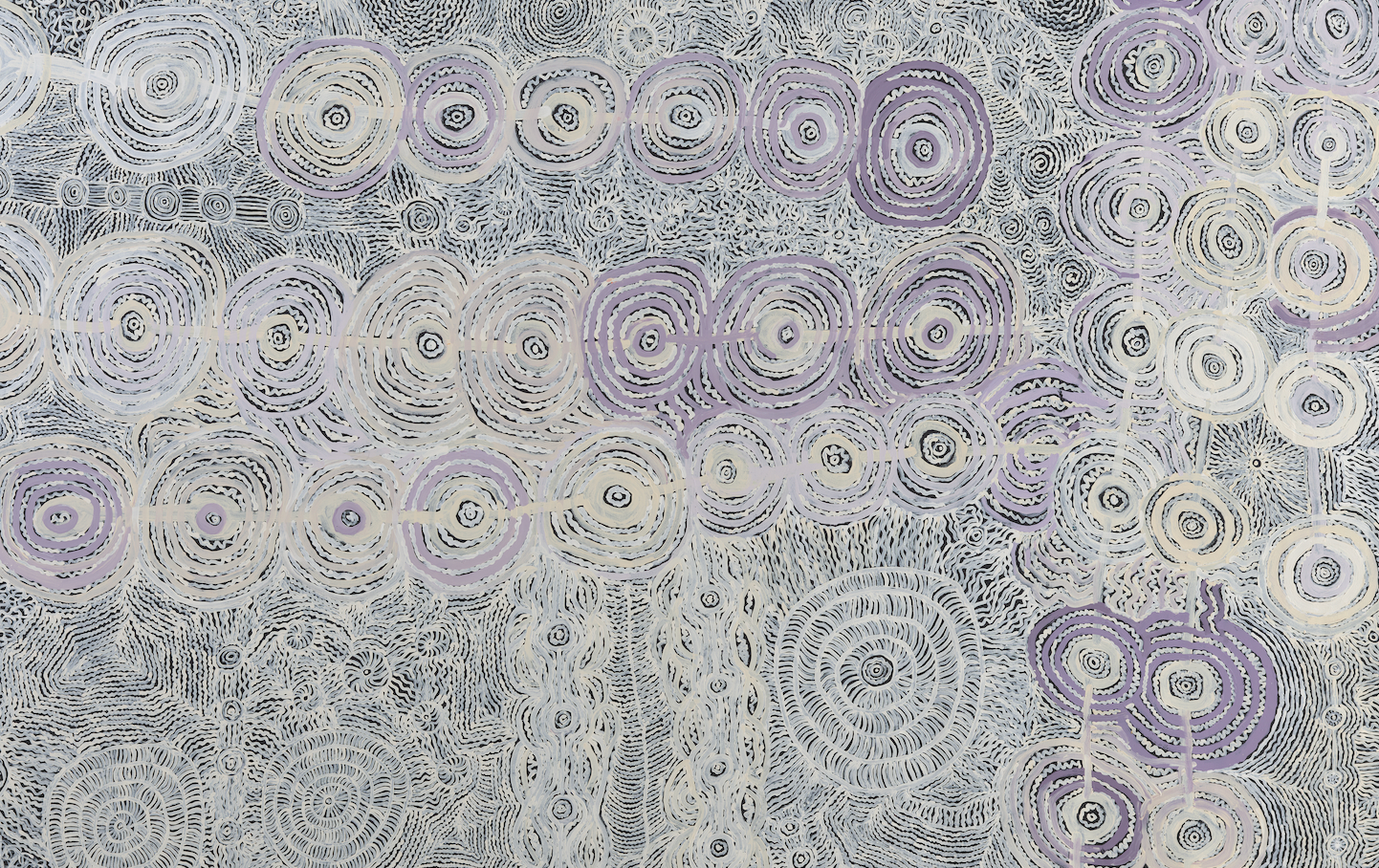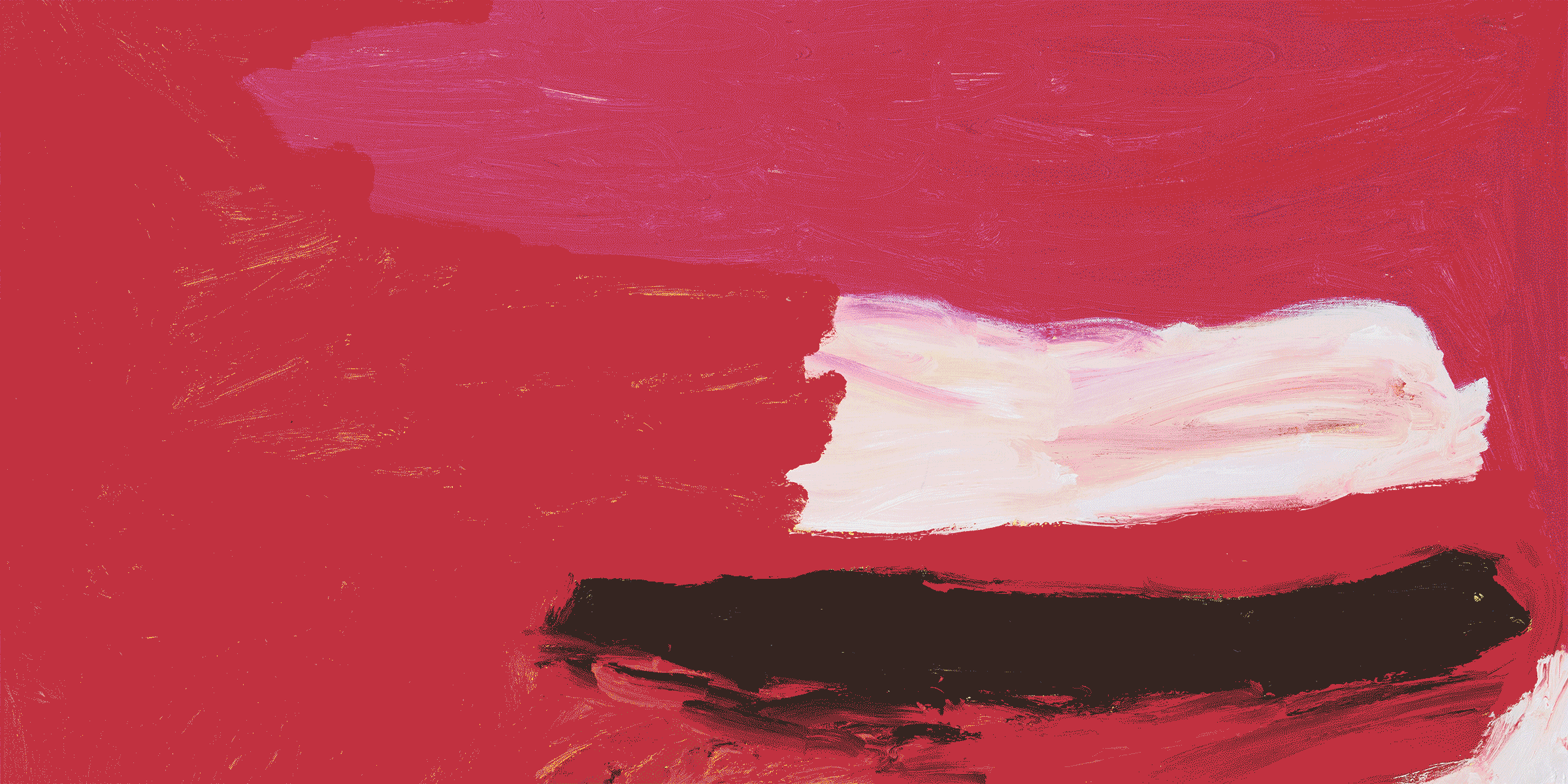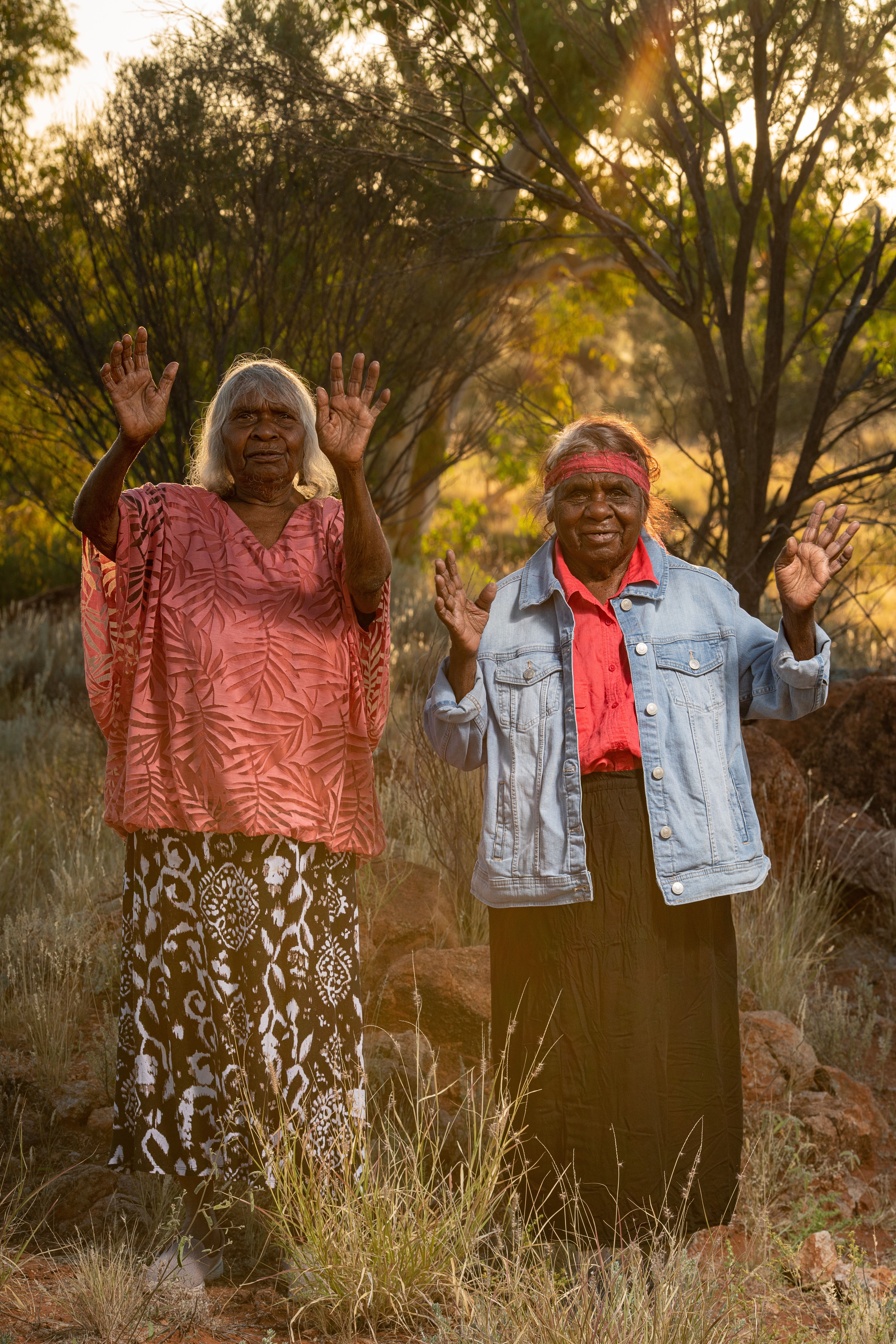
Maringka Burton & Betty Muffler
In collaboration
Artwork
Exhibitions

Desert + Coast: Seven Elder Aboriginal Painters
Biography

Courtesy of the artists and Iwantja Arts. Photo by Rhett Hammerton.
Maringka Burton
Maringka Burton is a respected senior artist born near Anumara Piti, the site of the Anumara Tjukurpa (Caterpillar Ancestral Creation Story). She has maintained a prolific creative and cultural practice across painting, drawing, and tjanpi (native grass) weaving. Her dynamic paintings are recognizable for their interconnected networks of tjukula (rock holes) that Burton renders, interwoven with designs related to her Tjukurpa. Her designs represent the multilinear networks created by the small green-and-white caterpillars that burrow tunnels and holes into the earth, tracing intricate patterns across the surface of the desert sands of her Country.
She grew up living a traditional Anangu life with her parents Charlie Tjalkuriny (Charlie Burton) and Naputja Yanyi (Yanyi Burton) and siblings before settling in Pukatja (Ernabella), where she attended the Ernabella Mission School. Following her schooling, Burton moved to Amata, where she was a health worker at the clinic, before eventually settling in Indulkana.
Burton is a highly regarded ngangkari (traditional healer), having been guided in this practice by her father. She travels extensively to assist doctors and nurses and with the Ngaanyatjarra Pitjantjatjara Yankunytjatjara (NPY) Women's Council for her ngangkari work. Burton also plays an integral role as a spokeswoman for ladies in the community, attending NPY Women’s Council meetings, and represents her community to advocate for Anangu women across the Anangu Pitjantjatjara Yankunytjatjara (APY) Lands, and at significant national and state events.
Burton’s work has been exhibited widely in both national and international exhibitions. Along with several recent solo exhibitions at Alcaston Gallery, Naarm (Melbourne), Victoria, her work has also featured in significant international exhibitions, including YOYI! Care, Repair, Heal (2022), Gropius Bau, Berlin, Germany; Kulata Tjuta (2020), Musée des Beaux-Arts, Rennes, Brittany, France; and Profundity (2022) and Wiltja – Shelter (2022), Aboriginal Signature Estrangin Gallery, Brussels, Belgium.
Burton also works collaboratively, particularly with her aunty and fellow senior Iwantja artist and ngankari Betty Muffler; their works center on aspects of healing and care, and knowledge and respect for Country, people, and place. Their work was recently commissioned for The National 2021: New Australian Art, Art Gallery of New South Wales (AGNSW), Sydney, and the pair was announced as finalists for the Wynne Prize (2021), also at AGNSW.
In 2023 Burton was a finalist for the prestigious Hadley’s Art Prize, a significant $100,000 acquisitive Australian landscape prize. Her work has been acquired by significant Australian institutions, such as the Art Gallery of New South Wales, Gadigal Country (Sydney) and Bendigo Art Gallery, Bendigo, Victoria.
Betty Muffler
Betty Muffler is a highly respected senior Pitjantjatjara woman with a contemporary art practice spanning painting, drawing, printmaking, and tjanpi (native grass) weaving. Muffler most often works with a monochrome approach to color, favoring soft whites, sometimes with the introduction of pastel hues. Rendered from an eagle’s perspective, Muffler’s work articulates interconnected and seemingly ever-expanding networks of energies and ecologies against stark black backgrounds. The densely layered and sprawling patterns that unfold throughout her work reflect the topographical features and cultural geography of her Country, specifically her birthplace at Yalungu, and often reference her father’s Country.
Muffler grew up at the Ernabella Mission in Pukatja, South Australia after being displaced from her homelands in the aftermath of the British nuclear testing at Maralinga and Emu Field throughout the 1950s. Her lived experience witnessing and surviving the devastation to Country that followed motivates her recurring depiction of healing sites, the “good places” on her Country, and her intent to convey a message: that greater respect to land is needed.
Additionally, Muffler is a renowned ngankari (traditional healer), having learned this practice from her aunties, from knowledge handed down through her father’s side. She works extensively with Ngaanyatjarra Pitjantjatjara Yankunytjatjara (NPY) Women’s Council and other medical services to support Aṉangu to good health and through times of crisis. Her ngankari and painting practices are intertwined; each brushstroke resonates with and responds to the energy that moves in, out, and through the body during her healing practice. She has explained: “My paintings are significant. They refer to my work as a healer of the body, and to my birthplace…I paint about my father’s eagle, and then I also paint a significant site for me—my birthplace—which relates to emus.”
Muffler has exhibited widely throughout Australia and internationally, including: NGV Triennial 2023, National Gallery of Victoria, Naarm (Melbourne), and the 14th Gwangju Biennale, Gwangju, South Korea. In 2022, Muffler presented her largest solo painting to date for the exhibition Like a Wheel That Turns: The 2022 Macfarlane Commissions, Australian Centre for Contemporary Art, Naarm (Melbourne). In 2022, Muffler was awarded the coveted National Aboriginal & Torres Strait Islander Art Awards General Painting Award from the Museum and Art Gallery of the Northern Territory, Darwin. Muffler’s work is held in significant public and private collections throughout Australia and internationally, including the National Gallery of Australia, National Gallery of Victoria, Art Gallery of New South Wales, Art Gallery of South Australia, and the Fondation Opale, Switzerland.